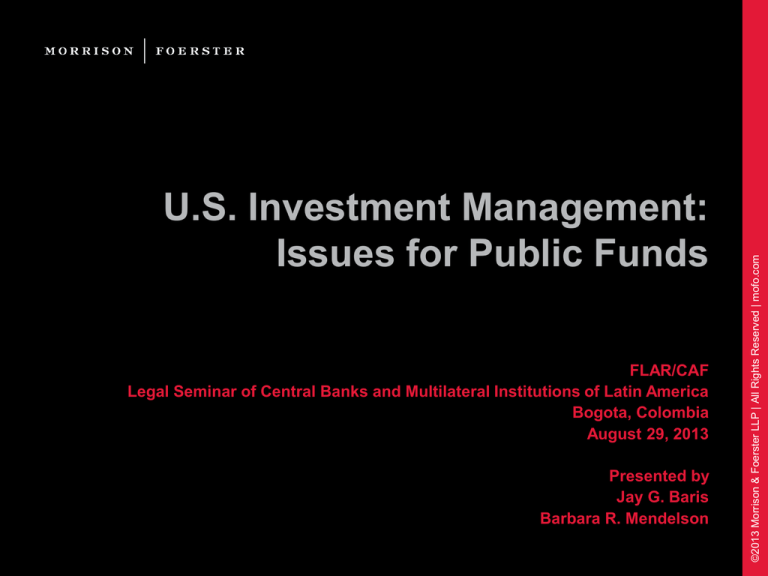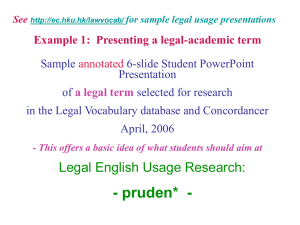
FLAR/CAF
Legal Seminar of Central Banks and Multilateral Institutions of Latin America
Bogota, Colombia
August 29, 2013
Presented by
Jay G. Baris
Barbara R. Mendelson
©2013 Morrison & Foerster LLP | All Rights Reserved | mofo.com
U.S. Investment Management:
Issues for Public Funds
Caveat
• This outline is for informational purposes only and does not constitute
legal advice or create an attorney-client relationship
• Consult your own attorney for legal advice on the issues discussed in
this outline
• IRS Circular 230 Disclosure
• To ensure compliance with the requirements imposed by the IRS, we inform you
that any tax advice contained in this communication was not intended or written to
be used, and cannot be used, for the purpose of (i) avoiding tax-related penalties
under the Internal Revenue Code or (ii) promoting, marketing, or recommending to
another party any matters addressed herein
• This outline may constitute attorney advertising
2
Introduction
• Topics for discussion
•
•
•
•
•
•
•
•
•
•
Overview of U.S. Financial Regulators
Principal U.S. Financial Laws
Standard of Care
Prudent Man Rule
Prudent Investor Standard
Fiduciary Standard
Investment of Public Funds
Investment Advisers Act of 1940
Selecting an Investment Adviser
U.S. Regulatory Environment
3
U.S. Financial Regulators
• Banking Regulators
• Comptroller of the Currency (part of U.S. Treasury)
• National banks and trust companies
• Board of Governors of Federal Reserve System
• Member banks (including national banks and state-chartered banks)
• Federal Deposit Insurance Corporation
• Regulates banks with respect to deposit insurance
• State banking commissioners
• Regulate state-chartered banks
• Securities Regulators
• Securities and Exchange Commission
• Regulates broker-dealers, investment advisers, investment companies,
securities exchanges and offerings of public securities
• Financial Institutions Regulatory Association
• Regulates broker-dealers (self-regulatory)
4
U.S. Financial Regulators
• Commodities Regulators
• Commodity Futures Trading Commission
• Regulates commodity pool operators (CPOs), commodity trading advisors
(CTAs) and commodity exchanges
• National Futures Association (NFA)
• Regulates CPOs and CTAs
• State Insurance Regulators
• No federal regulation of insurance companies
5
Principal U.S. Financial Laws
• Major Securities Laws
• Securities Exchange Act of 1933
• Regulates public offering of securities
• Securities Exchange Act of 1934
• Regulates trading of securities and exchanges
• Investment Company Act of 1940
• Regulates investment companies and business development companies
• Investment Advisers Act of 1940
• Regulates investment advisers
• Major Commodity Laws
• Commodity Exchange Act
• Notable Recent Amendments
• Sarbanes-Oxley Act of 2002
• Dodd-Frank Wall Street Reform and Consumer Protection Act of 2010
6
Standard of Care
• Standard of care for investment advisers and managers of public
funds
• State statutory and common law
• Prudent Investor Rule
• Investment Advisers Act of 1940 (Advisers Act)
• Investment advisers are fiduciaries
• Employee Retirement Income Security Act of 1974 (ERISA)
• Standard of care for managing retirement assets
7
Prudent Man Rule
• Until the mid-1990s, the common law standard of care for trustees
making of trust investments was the “prudent man” or “prudent
person” standard.
• Model Act
• Fiduciary shall “exercise the judgment and care under the circumstances then
prevailing, which men of prudence, discretion and intelligence exercise in the
management of their own affairs”
• Restatement
• a trustee owes a duty to the beneficiary in administering a trust “to exercise
such care and skill as a man of ordinary prudence would exercise in dealing
with his own property . . .”
• Supreme Judicial Court of Massachusetts (1830)
• When investing, a trustee “is to observe how men of prudence, discretion and
intelligence manage their own affairs, not in regard to speculation, but in
regard to the permanent disposition of their funds, considering the probable
income, as well as the probable safety of the capital to be invested”
8
Prudent Man Rule
• Judicial interpretations of the Prudent Man Rule severely limited how
trustees could invest
• Most important consideration – preservation of capital
• Fiduciary’s primary responsibility was never to lose money while investing
• Investments were expected to generate income
• Non-income producing assets were suspect or inappropriate
• Each investment was judged independently, without regard to how other
investments performed
• Trustee could be liable for losses incurred in a portfolio even if the portfolio’s
overall performance was excellent
• These standards made it difficult for fiduciaries to invest in anything
other than U.S. government securities and high-grade corporate
bonds
• In the 1980s, there was a push to change this standard to consider
portfolio theory investing
9
Prudent Investor Standard
• The Prudent Man Rule gave way to the Prudent Investor Rule
• Codified in the Uniform Prudent Investor Act (UPIA) in 1995
• Significant change in how fiduciaries may invest assets
• The standard of prudence applies to any investment as part of the total portfolio,
rather than to individual assets
• Hindsight no longer a component of the investment standard
• Tradeoff in all investing between risk and return is the fiduciary’s central
consideration
• Eliminates restrictions on specific types of investments
• Trustee can invest in anything that plays an appropriate role in achieving
risk/reward objectives (and that meets requirements of prudent investing)
• Derivatives, interests in limited partnerships, futures and not imprudent per se
• Diversification requirement integrated into definition of prudent investing
• Fiduciary may delegate investment authority, subject to safeguards
10
Prudent Investor Standard
• Almost all states have adopted versions of UPIA
• 44 states plus the District of Columbia
• 5 states have adopted their own modified versions
• As a preliminary matter, the Prudent Investor Rule provides:
• A trustee owes a fiduciary duty to the beneficiary
• The prudent investment rule is a default rule
• A trust may expand, restrict or eliminate its provisions
• Trustee not liable to beneficiary if it acts in reasonable compliance with the rule
11
Prudent Investor Standard
• What is the prudent investor standard?
• A trustee shall invest and manage trust assets as a prudent investor would, by
considering the purposes, terms, distribution requirements, and other
circumstances of the trust. In satisfying this standard, the trustee shall exercise
reasonable care, skill and caution
• A trustee’s investment and management decisions respecting individual assets
must be evaluated not in isolation but in the context of the trust portfolio as a
whole and as a part of an overall investment strategy having risk and return
objectives reasonable suited to the trust
• Fiduciary may add “risk” to a portfolio without fear of liability for the
loss on a single investment, viewed after the fact
• For example, market risk, liquidity risk, counterparty risk, inflation risk
• Inherent in this standard is that fiduciary must follow portfolio theory of investment
• Hedge against some risk, but some measure of risk will always remain
• No carte blanche to speculate or make high-risk/high-yield investments only
• OK to combine element of risk with traditionally conservative investments
12
Prudent Investor Standard
• Express authority to delegate investment authority
• Delegation to committees, officers, or employees of the institution or the fund
• May contract with independent investment advisers, investment counsel or
managers, banks or trust companies
• Change reflects tremendous complexity involved in investing
• To delegate investment authority, a fiduciary must
• Use reasonable care and skill in selecting an adviser
• Establish the scope and terms of the delegation, consistent with the purpose
and terms of the trust, and
• Periodically review the adviser’s actions in order to monitor the adviser’s
performance and compliance with the terms of the delegation
• If the fiduciary meets these standards, it should not be held liable for the losses
incurred by the adviser
13
Prudent Investor Standard
• What constitutes a “prudent investment”? UPIA provides guidance
with 8 factors
1.
2.
3.
4.
5.
6.
7.
8.
General economic conditions
The possible effect of inflation or deflation
The expected tax consequences of investment decisions or strategies
The role that each investment or course of action plays within the overall trust
portfolio (e.g., financial assets, interests in closely held enterprises, tangible and
intangible personal property, and real property)
The expected total return from income and capital appreciation
Other resources of the beneficiaries
Needs for liquidity, regularity of income and preservation or appreciation of
capital
The asset’s special relationship or special value, if any, to the purposes of the
trust or to one or more of the beneficiaries
14
Prudent Investor Standard
• Diversification
• A trustee shall diversify investments of the trust unless the trustee reasonably
determines that, because of special circumstances, the purposes of the trust are
better served without diversifying
• Duty of loyalty
• A trustee shall invest and manage the trust assets solely in the interest of the
beneficiaries
• Impartiality
• If a trust has two or more beneficiaries, the trustee shall act impartially in investing
and managing the trust assets, taking into account different interests
• Investment costs
• A trustee may incur costs that are appropriate and reasonable in relation to the
assets, the purposes of the trust, and the skills of the trustee
• Reviewing compliance
• Determined in light of the facts and circumstances at the time of the action, not in
hindsight
15
Fiduciary Standard
• General fiduciary principals
• A fiduciary has a duty of care and undivided loyalty to its clients
• Contrast fiduciary duty standard that applies to investment advisers to “suitability”
standard that applies to broker-dealers
• Broker-dealers are not subject to a fiduciary standard unless duly registered)
• “Suitability” means that the investment they choose must be suitable for
investor
16
Investment of Public Funds
• Standard of care for investing public funds varies from state to state
• Example: Alaska’s standards for investments of the Alaska
Permanent Fund (APF) (Alaska Statutes Sec. 37.13.120)
• The Board shall “adopt regulations specifically designating the types of income
producing investments eligible for investment of fund assets”
• The prudent investor rule applies
• As applied to the investment activity of the APF, the prudent investor rule means
that “judgment and care under the circumstances then prevailing that an
institutional investor of ordinary prudence, discretion and intelligence
exercises in the designation and management of large investments entrusted to it,
not in regard to speculation, but in regard to the permanent disposition of funds,
considering the preservation of the purchasing power of the fund over time while
maximizing the expected total return from both income and the appreciation of
capital”
• The corporation may not borrow money or guarantee a loan of others, except
that the corporation may, directly or indirectly, borrow money if the borrowing
is nonrecourse to the corporation and the fund
17
Investment of Public Funds
• Alaska’s standards for investments of APF, continued
• Diversification of assets
• Board shall “maintain a reasonable diversification among investments unless,
under the circumstances, it is clearly prudent not to do so”
• The board shall invest the assets of the APF in “in-state investments to the
extent that in-state investments are available” and if the in-state investments
• Have a risk level and expected return comparable to alternative investment
opportunities, and
• Are eligible for investment of fund assets under the prudent investor rule
• The corporation may enter into and enforce all contracts necessary, convenient or
desirable for managing the fund’s assets and corporate operations, including
contracts for future delivery to implement asset allocation strategies or to hedge
an existing equivalent ownership position in an investment
• By accepting delegation of investment authority, an adviser submits to the
jurisdiction of the state of Alaska (Alaska Stat. Sec. 13.36.240(d))
18
Investment Advisers Act of 1940
• The Investment Advisers Act of 1940 (IAA) created federal fiduciary
standards for investment advisers
• IAA does not specify precise fiduciary responsibilities
• The U.S. Supreme Court has interpreted Section 206 broadly because of the
fiduciary relationship of trust and confidence between the investment adviser and
the client
• The IAA “reflects a congressional recognition of the delicate fiduciary nature
of an investment advisory relationship” as well as an intent to eliminate or
expose conflicts of interest that might incline an investment adviser to provide
advice that was not disinterested (SEC v. Capital Gains Research Bureau
Inc.)
• As fiduciaries, investment advisers owe their clients “utmost good faith,” “full and
fair disclosure of all material facts” and “reasonable care to avoid misleading
them”
19
Investment Advisers Act of 1940
• Duty of care standard – Section 206
• Broad anti-fraud standard similar to that of other securities laws
• Applies to all investment advisers, whether or not registered with the SEC
• In general, Section 206 prohibits
• Any device, scheme, or artifice to defraud any client or prospective client
• Any transaction, practice or course of business that operates as a fraud or a
deceit upon any client or prospective client
• Trading any security with a client without following certain procedural steps
• Any act, practice, or course of business that is fraudulent, deceptive or
manipulative, for which the SEC has the rule-making authority
20
Investment Advisers Act of 1940
• Compliance obligations of registered advisers
• Subject to examination by Office of Compliance Inspections and Examinations
• Non-U.S. registered advisers must provide SEC with access to non-U.S.
personnel with respect to all activities
• Substantive requirements include
• Filing requirements
• Internal compliance program
• Record keeping
• Custody
• Principal trades with clients
• Anti-fraud
• Restrictions on advertising and public communications
• Restrictions on performance fees
• Pay-to-play
• Generally, substantive requirements of Advisers Act do not apply to non-US clients
of non-U.S. registered advisers
21
Investment Advisers Act of 1940
• Compliance obligations of registered advisers
• Must establish compliance procedures reasonably designed to detect and prevent
violations of federal securities laws, which should address, at a minimum:
• Portfolio management processes
• Trading practices
• Soft dollars
• Side-by-side trading
• Trade aggregation (bunching)
• Proprietary trading of adviser and its personnel
• Personal trading by supervised persons
• Accuracy of disclosures
• Safeguarding of client assets
• Creation and maintenance of records
• Marketing
• Valuation of assets
• Safeguarding of private information
• Business continuity
22
Selecting an Investment Adviser
• Tips for choosing an investment adviser
• Conduct rigorous due diligence
• Legal qualifications
•
•
•
•
•
Regulatory examinations
Disciplinary history
Background and experience of managers and analysts
Pending enforcement and litigation
Recent settlements
• Nature of business
•
•
•
•
•
Culture of transparency
Turnover of personnel
Financial stability
Recent events
Insurance
• Disclosure documents
• Form ADV
• Performance disclosures (no cherry picking)
23
Selecting an Investment Adviser
• Tips for choosing an investment adviser
• Conduct rigorous due diligence (continued)
• Portfolio management process and controls
• Experience with mandate
• Culture of compliance
• Nature and quality of compliance program
• Review of compliance policies
• Staffing of compliance function
• Experience of compliance officer
• Risk management
• Whistleblowing
• Conflicts of interest
•
•
•
•
Trade allocation
Aggregation of trades
Code of ethics (personal trading of employees)
Process for correcting trade errors
24
Selecting an Investment Adviser
• Tips for choosing an investment adviser
• Conduct rigorous due diligence (continued)
• Valuation procedures
• Use of pricing agents and override procedures
• Understanding of derivatives
• Trading capacity
• Business continuity
• Disaster recovery
• Succession planning
• Privacy and data protection
• Safeguarding information
• Record keeping
• Regulatory filings
• Document due diligence review
25
Selecting an Investment Adviser
• Tips for choosing an investment adviser
• Conduct rigorous due diligence (continued)
• Meet portfolio managers in person
• Check references
• Ongoing oversight of investment advisers
• Certifications
• Review internal and third party assessments
• Contractual notifications of material events
•
•
•
•
•
Violations of investment guidelines
Compliance issues
Lawsuits and enforcement actions
Regulatory examinations and communications with regulators
Staff changes
• Periodic in-person meetings
• Investment advisory contract
• Should address standard of care, indemnification, investment restrictions,
among other things
26
U.S. Regulatory Environment
• Enforcement trends
• SEC enforcement cases on the rise – reflects more aggressive approach
• YTD, as of August 6, 2013:
• Number of entities and individuals charged – 161
• Number of CEOs, CFOs, and other senior officers charged – 66
• Number of individuals barred or suspended – 36
• Penalties ordered or agreed to – $1.53 billion
• Disgorgement and prejudgment interest ordered or agreed to – $800 million
• Other monetary relief – $400 million
• Total penalties, disgorgement and other monetary relief – $2.73 billion
27
U.S. Regulatory Environment
• Enforcement trends
• Focus on insider trading
• Number of insider trading actions in FY 2012 – 58
• Number of insider trading actions over past three years – 168 (more than any
previous three-year period)
• High profile cases against hedge funds and their managers
• Focus on investment advisers and investment companies
• Number of actions in 2012 – 147
• Focus on financial fraud and disclosure
• Number of actions in 2012 – 79
• Total number of enforcement actions in 2012 – 734
• Enforcement lawyers participate in routine examinations of
investment advisers
28
U.S. Regulatory Environment
• Recent rulemaking concerns
•
•
•
•
•
•
•
•
•
Identity theft
Implementation of Dodd-Frank Act
“Pay to play”
Fiduciary standard for broker-dealers
Use of derivatives by investment companies
Money market funds
General solicitation and advertising in private offerings
Risk management
Shareholder access
29







